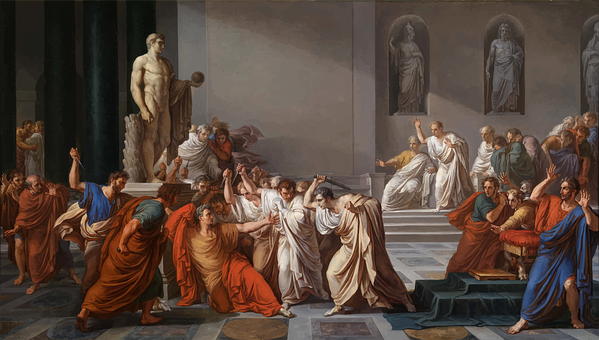When focusing on Christian art during the Roman Empire or simply the influence that the Roman Empire had on early Christian art, it is very important that one understands early Christianity as a whole. Why is this you ask? Well, there are two key moments that really helped shape Christian art back then especially if you are looking at it from the Roman Empire angle. Interestingly enough, these two key moments did not necessarily have anything to do with art or early Christian art for that matter. So what are these two key moments? Well, they are Apostle Paul’s decision to spread Christianity beyond Jewish communities of Palestine to other cities and the acceptance of Christianity by Emperor Constantine at the beginning of the fourth century.
Worth noting when it comes to matters Christianity during the Roman Empire is that back then Christianity was only in the Jewish community. In other words, it was a religion only practised or observed by mostly the Jews. With time however, especially given Apostle Paul’s effort to spread Christianity in both the Greek and Roman cities, it progressed considerably. Fast forward to the end of the first century and beginning of the second century and Christianity started to gain some traction. It was during the end of the first century that Christianity started attracting converts from a number of areas including one’s from the Greco-Roman world especially so in cities like Corinth, Ephesus, Rome and Thessalonica.
With the new additions to Christianity, especially from those under the Roman Empire, came new ideas, practises as well as traditions that slowly got adopted in Christianity. Like in any other situation these new ideas, practices and traditions also had an impact on Christian art. New Christians from the Roman world who happened to poses artistic heritage carried on with their practise of art and by doing so brought with them new and interesting ideas when it comes to matters Christian art. Upon seeing this new style of art Christian artists opted to borrow certain design, styles and forms.
Worth noting is the fact these new Christians utilised to the core their art ideas with some choosing to adopt a number of Roman artistic motifs and forms to help in expressing their new found faith. These artistic motifs and forms quickly gained traction in the world of Christian art with a number of them symbolising great moments in Christianity. That said, this post gets to look at some of this Christian art motifs and forms during the Roman Empire and what they symbolize.
Understanding Romans & Early Christians

Before delving deep into the artistic motifs and forms that characterised Christian art during the Roman Empire, it is important that we first highlight the relationship between early Christians and the Romans. Why? Well understanding the relationship (basically their similarities and differences) between early Christians as well as Romans, especially factoring in the Romans that opted to join Christianity, helps in clearly seeing the role Roman Empire played in shaping Christian art or simply the influence it had during those times.
During the Roman Empire, early Christians, just like the Romans, placed great value in using art as a means of expressing their personal beliefs as well as culture. In fact, the belief back then by early Christians was that artistic forms that were created enabled them to not only properly communicate with their faith but also helped them in intensifying their Christian faith. When the new Christians came in, Romans more so, they came in with a number of artistic motifs and forms that symbolized something about their Roman culture or faith. These artistic motifs and forms, despite not being created by Christians slowly started to be accepted by old Christians who too viewed them as a tool that enabled them to not intensify their faith but also communicate with their faith. With this particular belief in mind, more and more old-Christians quickly borrowed a number of artistic motifs and forms that were very popular with the Romans.
It’s not just artistic motifs and forms; early Christians, while still on matters art, also borrowed the Roman’s architectural endeavours, something that’s evident even today, you can actually see it by simply looking at Christian’s places of worship. When Christianity started out, most of the praying was done in private homes. When the time finally came when it was permitted to actually gather outside and practise one’s religion of choice, early Christians opted to go with a building that heavily borrowed from the Roman’s basilica. One of the main reasons for this was the design. Early Christians personally loved the basilica’s design as it allowed for a large crowd to gather. Furthermore, it had a nicely defined area which would easily play as an altar for the priest to be stationed.
Interestingly enough, early Christians, even before Christianity became legal, still embraced Roman’s architectural endeavours. Back then most of the prayers were done inside private houses. These private houses where they chose to worship in, they designed them in a similar way to the Romans. You’ll find that a house of worship had several rooms grouped around a central open courtyard. For baptism, a special occasion when one is sacramentally immersed in water, there was a special designed hall. These halls were achieved by removing a wall dividing two or more rooms.
Artistic Roman Motifs & Forms
Borrowed By Early Christians
The relationship among Christians and the Romans is very deep. They all looked at art from the same angle especially when it comes to significance or importance of any given art and also how to just go about doing it. In other words, both placed great emphasis on the use of art for cultural and personal expression. For instance, Christians, just like the Romans, who created water-colour paintings popularly known as frescoes did so knowing that the art they created symbolised something, whether personal or cultural. In case you are wondering, frescoes were basically art carvings done on plasters. That said, there are a number of Roman motifs early Christians borrowed back then. While not all of them will be covered, this post highlights some of the most common and important ones. What are they? Well, the borrowed motifs this post highlights are;
The Shepherd Motif
The Law Giver Figure
The Philosopher Motif
The Festive Meal & Triumphant Entry Motif
The Shepherd Motif
The Shepherd Motif is a very powerful metaphor when it comes to Christianity. Christians look at this figure as a perfect example of God’s nature as well as character which is basically the fact that he is compassionate and caring. That in mind, this figure is basically a beardless man with a sheep on his shoulders. It was a very common figure among Romans. In fact, this figure to Roman’s dates back to the 16th century.
The Law Giver Figure
The Law Giver Figure is another Roman motif that’s not only borrowed by early Christians but also happily embraced. What does it stand for? Well, it basically emphasises the supremacy Roman rulers held. For Christians however this particular figure was used to symbolise Christ. In particular, it was used in symbolizing Christ as the supreme law giver of Christians.
The Philosopher Motif
This particular Roman motif, usually an authoritative teacher wearing a toga while at the same time holding a scroll, was embraced by Christians as a figure depicting not only Christ but also his apostles.
The Festive Meal & Triumphant Entry Figure
Like the name suggests this particular Roman motif symbolized festivity or celebrations in general. For early Christians however, this motif was used to symbolize the Eucharist. The Triumphant Entry motif on the other hand basically symbolised victories. In particular, victories that were achieved by Roman rulers. Early Christians who embraced this motif used it to show Jesus’ entry into Jerusalem.
What’s been covered in this post clearly depicts the transformation early Christian art underwent during the Roman Empire. Not only did art change back then but the meaning of the Christian art created also changed drastically. While a big reason for this transformation was Apostle’s Paul decision to spread Christianity to surrounding cities, Constantine acceptance of Christianity played a big role as well as it was during this time that Christianity as well as Christian art underwent a fundamental transformation. Worth noting when talking about Constantine after accepting Christianity is that prior to this decision Christian art imagery only appealed to believer’s desires for personal salvation while after his acceptance a dominant theme emerged and that is emphasis on authority of Christ and His Church in the world. Furthermore, it was only after Constantine accepted Christianity did we start to see Christian imagery dominating. Christian art that now helps in depicting important moments in Christianity like the crucifixion, resurrection or even Nativity were not as dominant or some cases present before Constantine accepted Christianity.

